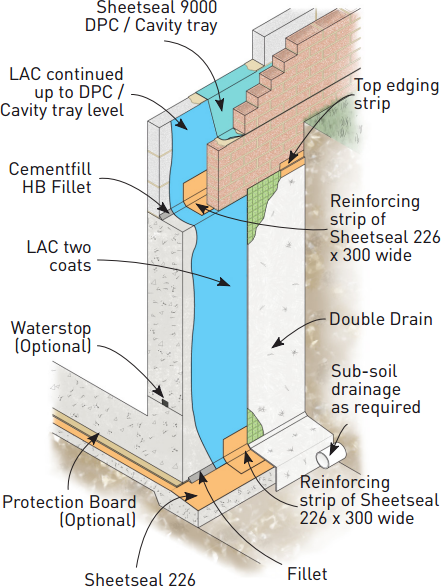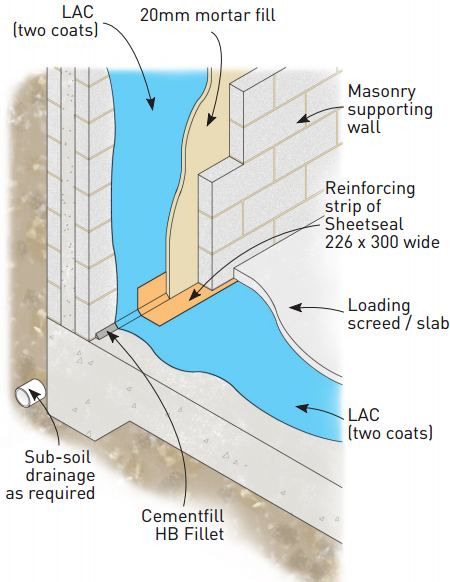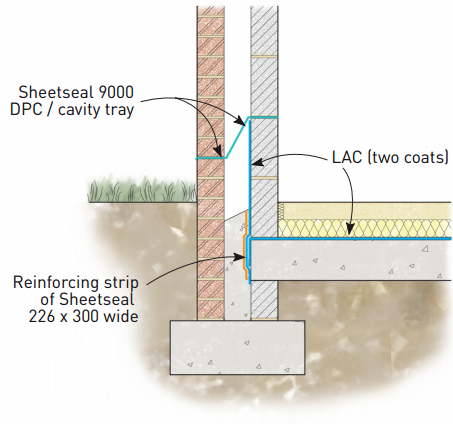Liquid Asphaltic Composition is a two coat, cold applied damp proof membrane, which dries to a uniform gloss black finish. The coating is a solution of natural and petroleum bitumens in white spirit.
BENEFITS
- Water and water vapour barrier
- Radon barrier
- Elastic and flexible
- Easily applied and adapted to difficult details
- Sulphate resistant
APPLICATIONS
- Ground floors
- Superstructures
- Basement and Sub-structures
- Retaining walls
APPLIED TO
- Concrete
- Masonry
- Steel
TYPICAL USES
LAC is typically used as a damp proof membrane to ground floors, as a vapour barrier behind cladding and for tanking of basements. It is also suitable for waterproofing foundation walls, ducts, lintels, columns, beams and similar structures at, above and below ground level.
When designing Type A structures (as classified in BS 8102: 2009), the product applied correctly is capable of providing the levels of protection required for Grades 1, 2 & 3 basements.
LAC may also be applied to the internal face of external walls above ground level to prevent the penetration of moisture. The membrane can then be plastered or dry lined when dry.
LAC may also be used to provide a barrier to Radon Gas.
DURABILITY
Subject to normal conditions of use LAC will provide an effective barrier to the transmission of liquid water and water vapour for the life of the structure.
LAC retains its elasticity and will not crack or peel provided it is protected from mechanical damage and exposure to U.V. light.
SPECIFICATION
J30 - Liquid Applied Tanking/Damp Proofing in accordance with NBS Clauses.
Please consult RIW for further information.
INDEPENDENT AUTHORITY
LAC has been awarded British Board of Agrément Certificate No. 89/2278, covering its use for the tanking of basements and as a damp proof membrane for solid floors.
Tests carried out by the National Radiological Protection Board show that LAC will provide a barrier to the passage of Radon by diffusion.
A copy of their report is available upon request.
ANCILLARY PRODUCTS
RIW produce a range of ancillary products for use with LAC which include:
Cementfill FC - Cement based waterproof fairing coat and repair mortar for filling minor holes, voids and defects.
Cementfill HB - Cement based waterproof high build repair mortar for profiling and providing fillets.
Sheetseal 226 - a self-adhesive, flexible sheet membrane for reinforcing areas subject to movement.
Double Drain - a drainage board which protects the membrane during backfilling operations and also promotes drainage of water away from the structure.
Protection Board - a 3mm rot proof bitumen board to prevent damage to the waterproof membrane during backfilling operations.
Adhesive Tape - a 150mm wide double sided tape for temporarily adhering Protection Board or Double Drain to the membrane.
Sheetseal 9000 DPC - a range of high performance polymeric dpc's, and pre-formed cavity trays, compatible for use with all RIW membranes.
PERFORMANCE & COMPOSITION
| Form | Bitumen Solution |
| Colour | Black |
| Specific gravity | 0.95g/ml |
| Solids Content | 71% (w/w) |
| Flash Point | 38°C |
| Water vapour resistance | 590MNs/g |
| Water vapour permeability | 0.43g/m2 per 24 hours |
| Diffusion coefficient for radon | 1.7 x 10-13 m2 s-1 |
| Diffusion length for radon | 0.28mm |
| Coverage for two coats * | 1m2/litre (typical) |
| Number of coats | Two (One coat only onto render prior to plastering) |
| DFT of coating | 0.75mm for two coats |
| Curing time | Touch dry: 24 hours |
| Overcoating time | Minimum: when touch dry |
| Application temperature limits | 5-35°C |
| Preparation of liquid | None |
| Sulphate resistance | 50,000ppm |
| U.V. resistance | Low, protect within 28 days |
Shelf life (Temperate climate) | 12 months |
The above performance figures are typical values and should not be considered a product specification.
*Figures quoted are theoretical coverage rates. Actual coverage may vary depending on nature of substrate.
CONSTRUCTION
All construction should conform with the Building Regulations, Codes of Practice and British Standards in current use at the time the building is being constructed. In particular it is recommended that reference is made to BS 8102: 2009.
PREPARATION
All Surfaces: Should be smooth, clean, dry (to a depth of 1-2mm), sound and free from frost, oil, grease, condensation and other contamination. Any voids or hollows must be made good to a flush finish, with a suitable filler. Any sharp edges or high points should be eliminated. Powdery or flaking surfaces should be removed by suitable means.
Internal corners should be eased with a cement fillet (see ancillary products), approximately 20mm high to assist application, similarly, external corners should be chamfered or rounded to suit.
Concrete surfaces: Horizontal surfaces should preferably be smooth, however lightly tamped (3-4mm peak to trough profile), brushed or floated surfaces may also be acceptable.
Masonry: Should be sound with joints flush pointed or 'bagged out' with Cementfill or similar before the membrane is applied. Open textured surfaces should be sealed with Cementfill FC or a sand/cement slurry to provide a suitable surface. If existing surfaces are very rough, they may require rendering.
Metal surfaces: Should be wire brushed or sand blasted and pre-treated with a steel primer, prior to the application of the membrane, in two coats, at the rate of 2.5m2 /litre per coat. Corroded metal should also be treated with an anti-corrosive primer. LAC is compatible with all commonly encountered steel primers including alkyd, chlorinated rubber and epoxy based paints.
APPLICATION
General: Application of LAC should not be attempted in temperatures below 5°C. LAC should be applied as supplied, however under certain circumstances, such as cold weather conditions, it may be necessary to addup to 10% white spirit to ease application.
LAC should be applied in two coats at a minimum application rate of 1.7m2/litre for the first coat and 2.5m2/litre for the second coat, unless noted otherwise. Under no circumstances must the liquid be heated or sanded. The coating is not designed for external exposed use, and must be protected from the effects of U.V. light within 28 days of application. Heviseal may be used as an alternative to LAC where exposure will exceed 28 days.
Manual: LAC can be applied using a stiff brush or pile roller. The material should be transferred into a suitable container and applied to the substrate by brushing vigorously in all directions to ensure uniform coverage. Do not pour the material onto the substrate or allow it to pool in serrations or depressions.
Good ventilation is necessary to obtain a proper cure. LAC will require 24 hours minimum before recoating.
Spray: For further information and details of Specialist Applicators, please consult the Technical Department.
COMPATIBILITIES
Damp-proof courses : LAC is compatible for use with Sheetseal 9000 DPC and all commonly used DPC material, except those with a polymer base. Pitch polymer based products contain plasticizers which migrate under pressure into surrounding materials. This effect does not occur with bitumen polymer, polymeric, lead or hessian based DPC materials.
Insulation Boards : When used as a DPM, LAC is fully compatible with all commonly encountered insulation materials, provided it has dried throughout its thickness before being covered.
SPECIFIC USES
Tanking: LAC should always be fully supported, to resist hydrostatic pressure, when used for tanking.
External tanking: Should be carried out as illustrated in Detail 1 of this literature. The horizontal membrane should be laid on a concrete blinding projecting beyond the outer face of the structure.

The base structural slabs and the walls should be formed, incorporating a fillet at the external base of the wall, and the vertical LAC should then be applied. The internal angle at the base of the wall, and other areas subject to movement, must be reinforced with a 300mm strip of Sheetseal 226. The membrane should then be protected from backfilling using Double Drain or Protection Board to suit.
Internal tanking: Should be carried out as illustrated in Detail 2 of this literature. All internal angles, and other areas subject to movement, must be reinforced with Sheetseal 226 as required. A loading coat of brick, block or concrete should be constructed immediately after the membrane has cured. If brick or block is used, a 20mm minimum cavity should be left between the membrane and the loading skin. This cavity must be filled with a sand/cement mortar fill as work proceeds.
Floating floor construction: LAC can be used under a floating floor system at ground level, as illustrated in Detail 3 of this literature. When used under insulation the following guidelines should be followed:
- The product must be allowed to dry throughout its thickness before being covered.
- The insulation boards must be laid butt jointed, with corners and arrises kept intact to ensure overall loading of the membrane.
- The floor finish must not displace the insulation boards during laying.
Radon Barrier: Refer to BRE Report 211 - Radon: Guidance on protective measures for new dwellings. LAC has been successfully tested by the National Radiological Protection Board, as an effective barrier against radon. This gives the specifier the opportunity of using a traditional proven material as both a radon barrier and in its normal use, as a water and water vapour barrier. The principal design objective is to construct an airtight and therefore radon proof barrier across the whole site of the building. This can be achieved without the need for skilled labour, or site welded lap joints, by using LAC.
Vapour barrier behind plastering: LAC is suitable for use under the following plasters, Thistle Bonding or Thistle Universal Onecoat, and only these products can be recommended. Under no circumstances should cement or lime based renders be applied to the vertical membrane.
LAC should be applied to a correctly prepared surface, including the removal of efflorescence, old plasters, lime washes etc. The second coat, where required should not be applied until the first coat is dry throughout its thickness, and neither coat should be applied so heavily as to form curtains and sags down the face of the wall.
If LAC is to be applied to dense concrete, sand/cement render or (semi-) engineering brickwork, only one coat of the membrane is required, at a rate of 1.7m2/litre. The membrane should never be sanded, as the recommended plasters will bond directly to the membrane. Plastering should never be carried out until the full treatment (one or two coats) is totally dry throughout its thickness. The membrane must be reactivated by wiping a rag moistened in white spirit prior to over-plastering if the membrane has been exposed for 21 days (allow to dry for 4 hours).
Points for fixings should be indicated and pockets cut out which should then be filled with mortar after lining with LAC. Lightweight fixings may be adhered directly to the plaster finish using an appropriate adhesive.


SAFETY
LAC is flammable and should be used in wellventilated areas away from sources of ignition. The product can effect sensitive skins. Gloves or barrier cream should always be used by operatives and hands thoroughly washed at the end of each working period. Do not allow the product to enter watercourses. Full health and safety instructions are contained on the product material safety data sheets, and these must be referred to before use.
SUPPLY
AVAILABILITY
All RIW products can be obtained through Builders Merchants or approved stockists. A list of approved stockists is available from RIW offices.
PACKAGING
5 & 25 litre containers
STORAGE
There are no special requirements, however prolonged storage (in excess of 12 months) may result in some loss of solvents, causing an increase in viscosity. The material may be stored in severe winter environments without any detrimental effect.
TECHNICAL SERVICES
The Technical Department is available to advise on individual projects and to prepare or assist in the preparation of specifications and drawings. A list of experienced applicators of our materials is available from RIW's offices.
For the latest information, please consult RIW. Conditions of use are beyond our control, therefore we cannot warrant the results to be obtained.
DOWNLOAD
Click here to download this information in PDF format.




